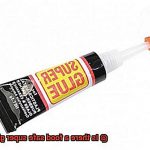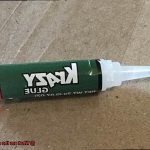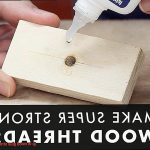Calling all food enthusiasts and DIY lovers.
Contents
- 1 What is Wood Glue?
- 2 Is Wood Glue Food Safe When Dry?
- 3 What Are the Risks of Using Wood Glue on Food-Related Items?
- 4 What Are the Alternatives to Wood Glue for Food-Related Projects?
- 5 How Can You Ensure that Your Project is Food Safe?
- 6 Tips for Working with Wood Glue and Other Adhesives in Food-Related Projects
- 7 Conclusion
Ever pondered whether the wooden cutting board you fashioned with your own two hands is truly safe for food prep? Fear not, my friends.
Today, we’re delving into the captivating realm of wood glue and its food safety once it’s dry. Wood glue is a go-to adhesive in woodworking projects, but here’s the burning question: Is it truly food safe?
So, if you’re itching to know whether your kitchen creations are culinary comrades or potential health hazards, stick around and let’s dive into some glue knowledge.
What is Wood Glue?
In this comprehensive guide, we will delve into the world of wood glue, exploring its various types, properties, applications, and safety considerations. Whether you’re a beginner or a seasoned woodworker, this article will equip you with the knowledge you need to make informed decisions about using wood glue.
What is Wood Glue?
Wood glue is an adhesive specifically formulated for bonding pieces of wood together. It comes in liquid form and is applied to the surfaces that require joining. As it dries, the glue penetrates the wood fibers, creating a strong and durable bond.
Types of Wood Glue:
- PVA Glue: Polyvinyl acetate (PVA) glue is the most common type of wood glue. It is water-based, non-toxic, and known for its excellent bond strength, fast drying time, and easy cleanup with water. PVA glue is suitable for most woodworking projects.
- Polyurethane Glue: Polyurethane glue reacts with moisture in the air to cure and form a bond. This type of glue offers exceptional strength and water resistance, making it ideal for both indoor and outdoor applications.
- Epoxy-based Glue: Epoxy-based wood glues provide an extremely strong bond and are often used for structural repairs. They exhibit resistance to heat, chemicals, and moisture.
- Heat-resistant Glue: Heat-resistant wood glues can withstand high temperatures, making them suitable for projects such as veneering or laminating.
Uses of Wood Glue:
Wood glue has a wide range of applications in woodworking projects, including:
- Joining wooden panels or boards
- Repairing broken furniture
- Creating wooden crafts
- Installing wooden flooring or molding
- Veneering or laminating projects
Safety Considerations:

While most wood glues are non-toxic when fully cured, it is important to note that they are not designed for direct contact with food. Therefore, surfaces bonded with wood glue should be adequately sealed or coated with food-safe finishes before coming into contact with food.
Is Wood Glue Food Safe When Dry?
Wood glue, a versatile adhesive commonly used in woodworking projects, is known for its strong bonding properties that make it ideal for joining pieces of wood together. However, when it comes to using wood glue in projects involving food, its safety must be carefully considered.
Most wood glues contain chemicals such as formaldehyde and polyvinyl acetate (PVA) that may prove harmful if ingested. These chemicals are utilized to enhance the adhesive properties of the glue, ensuring a robust bond. Regrettably, the Food and Drug Administration (FDA) has not approved wood glue for direct contact with food. Consequently, it should not be employed on items like cutting boards or kitchen utensils that directly interact with food.
Furthermore, the adhesive properties of wood glue can deteriorate over time, particularly when exposed to moisture or high temperatures. This degradation can result in the release of potentially dangerous chemicals into the surrounding environment.
To ensure food safety in woodworking projects, it is advisable to utilize adhesives explicitly designed for direct contact with food. These adhesives are typically labeled as “food-safe” or “FDA-approved” and can be conveniently obtained from specialty stores or online retailers. It is crucial to follow the manufacturer’s instructions precisely and reach out to them directly if there are any doubts regarding the safety of a particular wood glue.
What Are the Risks of Using Wood Glue on Food-Related Items?
Today, we embark on a quest to uncover the hidden dangers lurking in the shadows of wood glue when it comes to food-related items. While wood glue may work wonders for woodworking projects, venturing into the realm of edibles requires caution and knowledge. Let us delve into the potential risks that lie ahead and discover safer alternatives to protect our palates.
Harmful Chemical Release:
Within the depths of wood glue reside a concoction of chemicals like formaldehyde, toluene, and benzene. These substances, when ingested, can pose a toxic threat to our bodies. Although the concentration of these chemicals in dried wood glue may not be alarming, there remains a chance for migration into our beloved food, especially when exposed to the elements of heat and moisture.
Cleaning and Sanitizing Challenges:
Unlike their culinary counterparts such as epoxy or food-grade silicone, wood glues lack the fortitude to withstand high temperatures or prolonged encounters with water. Consequently, effectively cleaning and sanitizing food-related items bonded with wood glue becomes an insurmountable challenge. This failure in cleanliness opens the door to bacterial growth and contamination, casting a shadow over our dining experiences.
Durability Concerns:
Wood glue was not forged in the fires of resilience; it simply lacks the endurance necessary for repeated washing or extended submersion. Over time, this adhesive may crumble under pressure, leading to disintegration and separation of bonded parts. In this state of disarray, loose pieces of wood or remnants of glue can infiltrate our meals, presenting potential choking hazards or causing us to inadvertently ingest foreign objects.
Lack of FDA Approval:
When considering the safety of materials used in food preparation and storage, it is vital to acknowledge that wood glue has not received the esteemed seal of approval from the Food and Drug Administration (FDA). This esteemed authority sets rigorous standards to ensure consumer well-being. Unfortunately, wood glue fails to meet these stringent requirements, rendering it unsuitable for surfaces that directly interact with our precious sustenance.
Legal Implications:
Venturing into the treacherous territory of non-approved adhesives like wood glue on food-related items can thrust us into a world of legal conundrums. Numerous countries boast regulations and standards governing materials used in food preparation and storage. By transgressing these laws and utilizing wood glue, we expose ourselves to penalties and potential legal repercussions that could tarnish our reputations.
What Are the Alternatives to Wood Glue for Food-Related Projects?
Today, we embark on a journey through the diverse realm of food-safe adhesives, exploring alternatives to traditional wood glue for all your tantalizing food-related projects. So, put on your creative aprons and let’s dive into the world of culinary craftsmanship.

Epoxy Resin: The Versatile Bonding Agent
Our first contender is the mighty epoxy resin. With its ability to bond various materials, including wood, epoxy resin is a go-to adhesive for food-related projects like cutting boards, serving trays, and utensils. This adhesive forms a strong and durable bond that withstands the test of time when properly cured. So, unleash your creativity and create stunning pieces that are as functional as they are beautiful.
Food-Grade Silicone Adhesive: Heat-Resistant Brilliance
Next up is food-grade silicone adhesive – a true champion when it comes to sealing joints and gaps in food-related projects. This non-toxic and odorless adhesive not only provides a reliable bond but also boasts resistance to high temperatures. From assembling culinary masterpieces to fixing cherished kitchen tools, this adhesive has got your back in any hot situation.
Food-Safe Polyurethane Glue: Water-Resistance at Its Finest
For those seeking an adhesive with water-resistance capabilities, food-safe polyurethane glue is the answer. This versatile glue creates a robust bond between wood surfaces and is commonly used in crafting wooden kitchenware like bowls, spoons, and cutting boards. With its water-resistant properties, you can rest assured that your creations will endure countless culinary adventures without losing their integrity.
Food-Grade Wax: A Temporary Bond for Small Projects
For smaller projects or repairs, consider turning to the natural wonders of food-grade wax. Made from ingredients like beeswax or carnauba wax, this temporary adhesive is safe for use on surfaces that come into contact with food. While it may not provide a permanent bond, it can be easily removed when necessary, making it ideal for quick fixes and small-scale projects.
Remember:
When venturing into the world of food-safe adhesives, always read product labels and look for certifications such as FDA approval or NSF certification. These indicators assure you that the adhesive has undergone rigorous testing to ensure its safety for direct or indirect contact with food.
How Can You Ensure that Your Project is Food Safe?
In this post, we will dive into the world of wood glue and discuss how you can ensure that your project is not only visually stunning but also safe for food contact.
Choose the Right Wood Glue:
To kickstart your food safety journey, the first step is to carefully select a wood glue that is specifically labeled as food safe. Look for products certified by regulatory bodies like the FDA, ensuring that they meet stringent safety standards. By choosing the right glue from the start, you can rest assured that your project is off to a safe start.
Follow Manufacturer’s Instructions:
Achieving optimal results requires meticulous attention to detail. Follow the manufacturer’s instructions diligently, ensuring you use the appropriate amount of glue and adhere to proper drying times. Rushing the drying process can compromise adhesive properties, potentially leading to contamination risks.
Consider the Intended Use:
If your project will come into direct contact with food or beverages, it’s wise to take additional precautions. Apply a food-safe finish over the glued surfaces as an extra layer of protection, ensuring no harmful substances leach into the food.
Practice Regular Maintenance and Cleaning:
Just like any other kitchen tool or surface, regular maintenance and cleaning are essential for ongoing food safety. Regularly sanitize wood surfaces using appropriate cleaning agents safe for food-contact surfaces. This simple step helps prevent the growth of bacteria or other pathogens that could potentially contaminate your food.
Inspect for Deterioration:
Over time, exposure to moisture and temperature fluctuations can weaken adhesive bonds. Periodically inspect your project for signs of deterioration or damage in the glued areas. Promptly address any issues to maintain project integrity and ensure continued food safety.
Tips for Working with Wood Glue and Other Adhesives in Food-Related Projects
When it comes to food-related projects, using wood glue and other adhesives requires special precautions. In this article, we will explore important tips and precautions to keep in mind when working with these adhesives in food-related projects, ensuring safety and durability.
Choose a Food-Safe Glue:
In food-related projects, it is crucial to use adhesives that are specifically labeled as food safe. Look for wood glues that are non-toxic and FDA-approved for indirect food contact. These glues have undergone rigorous testing to ensure they are safe for use in applications where they may come into contact with food.
Follow Manufacturer’s Instructions:
Before using wood glue, carefully read and follow the manufacturer’s instructions. Different types of wood glues may have specific requirements for application and drying time. By following these instructions, you can ensure proper usage and maximize the effectiveness of the adhesive.
Apply Glue Sparingly and Evenly:
When applying wood glue, it is important to use just enough to create a strong bond without excess seeping into the wood or coming into contact with the food. Apply a thin layer of glue evenly on both surfaces that need to be bonded together. This will help ensure a secure bond while minimizing any potential contamination risks.
Allow Sufficient Drying Time:
To ensure the wood glue sets properly, allow it to fully dry before using the project for food-related purposes. Rushing the drying process may compromise the strength of the bond or introduce unwanted chemicals into your project. Typically, wood glue takes around 24 hours to dry, but it is always best to check the manufacturer’s instructions for specific drying times.
Consider Waterproof or Water-Resistant Glues:
In food-related projects where exposure to liquids is expected, choosing wood glues that are waterproof or water-resistant is essential. These glues are designed to hold up well in humid environments or when exposed to water or sauces. Look for labels indicating outdoor use or waterproof properties.
Also Read: Is Glue Edible? – Glue Things
Conclusion
In conclusion, when it comes to food safety, dry wood glue doesn’t make the cut. Although it’s a versatile adhesive commonly used in woodworking, it contains chemicals like formaldehyde and polyvinyl acetate (PVA) that could be harmful if consumed. The Food and Drug Administration (FDA) hasn’t given its approval for wood glue to come into direct contact with food, so it’s a no-go for using on cutting boards or kitchen utensils.
And that’s not all – when exposed to moisture or high temperatures, wood glue can break down over time, potentially releasing dangerous chemicals into the air. This deterioration not only weakens the bond but also increases the risk of contamination.
To ensure your woodworking projects are food-safe, it’s best to opt for adhesives specifically designed for direct contact with food. Look out for those labeled as “food-safe” or “FDA-approved,” which you can easily find at specialty stores or online retailers.
If you’re working on a project involving food, there are alternatives to wood glue that are more suitable. Consider using epoxy resin, food-grade silicone adhesive, food-safe polyurethane glue, or even food-grade wax. These options are specially formulated to be safe for use when they may come into contact with food.
Remember to follow the manufacturer’s instructions when working with wood glue or other adhesives in food-related projects. Apply the glue sparingly and evenly, allow enough drying time, and consider waterproof or water-resistant options for projects that will encounter liquids.






